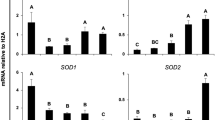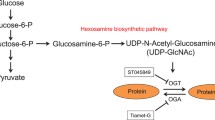Abstract
DM1 complicated with pregnancy is the cause of neonatal malformations and low-for-gestational-age neonates. With the use of the whole-embryo culture system, it has been demonstrated that high glucose causes embryo dysmorphogenesis. Previously, our group has found that spermidine or spermine addition reverts almost fully the severity and frequency of dysmorphogenesis, whereas the effect of arginine and putrescine it is only partial. A hypothesis for polyamine mechanism is the amelioration of oxidative stress caused by high glucose. The purpose of this work was to evaluate the effect of polyamines over the activity of scavenging enzymes and lipoperoxidation in whole-embryo rat in culture. Post-implantation (gestational day 10.5) rat embryos were cultured for 24 h in normal medium or hyperglycemic medium, alone or supplemented with l-arginine or polyamine. Embryos were recovered and visualized, and morphologic parameters were registered. Cultured embryos were homogenized, and superoxide dismutase and glutathione-reductase activities, as well as lipoperoxidation, were measured. The activity of superoxide dismutase and glutathione peroxidase were not affected by the treatment, but lipoperoxidation was increased in embryos cultured in hyperglycemic medium; spermidine or spermine supplementation restore lipoperoxidation to near-normal values, and putrescine and l-arginine reverts only partially the glucose effect. Taken together, these results pointed out that spermidine and spermine embryoprotection could be mediated by direct antioxidant activity. However, further studies are needed to support this hypothesis.




Similar content being viewed by others
References
Abramov J. P.; Wells P. G. Embryonic catalase protects against endogenous and phenytoin-enhanced DNA oxidation and embryopathies in acatalasemic and human catalase-expressing mice. FASEB J 25: 2188–2200; 2011a.
Abramov J. P.; Wells P. G. Embryoprotective role of endogenous catalase in acatalasemic and human catalase-expressing mouse embryos exposed in culture to developmental and phenytoin-enhanced oxidative stress. Toxicol Sci 120: 428–438; 2011b.
Aebi H. E. Oxidoreductases acting on groups other than CHOH. 3.9 Catalase: hydrogen-peroxidase: hydrogen-peroxidase oxidoreductase E.C. 1.11.1.6. In: Bergmeyer H. U. (ed) Methods of enzymatic analysis, vol. 3. Weinheim, Verlag Chemie, pp 273–286; 1983.
Beauchamp C.; Fridovich I. Superoxide dismutase: improved assays and assay aplicable to acrylamide gels. Analyt Biochem 44: 276–287; 1971.
Bellé N. A. V.; Dalmolin G. D.; Fonini G.; Rubin M. A.; Rocha J. B. T. Polyamines reduces lipid peroxidation induced by different pro-oxidant agents. Brain Res 1008: 245–251; 2004.
Cederberg J.; Eriksson U. H. Decreased catalase activity in malformation-prone embryos of diabetic rats. Teratology 56: 350–357; 1997.
Cederberg J.; Eriksson U. H. Antioxidative treatment of pregnant diabetic rats diminishes embryonic dysmorphogenesis. Birth Def Res (Part A) 73: 498–505; 2005.
Cederberg J.; Galli J.; Holger L.; Eriksson U. Increased mRNA levels of Mn-SOD and catalase in embryos of diabetic rats from a malformation-resistant strain. Diabetes 49: 101–107; 2000.
Cederberg J.; Simán C. M.; Eriksson U. J. Combined treatment with vitamin E and vitamin C decreases oxidative stress and improves fetal outcome in experimental diabetic pregnancy. Pediatr Res 49: 755–762; 2001.
Chirino-Galindo G.; Baiza-Gutman L. A.; Barrera-Escorcia E.; Palomar-Morales M. Polyamines protect rat embryo in vitro from high glucose-induced developmental delay and dysmorphogenesis. Birth Def Res (Part B) 86: 58–64; 2009.
Das K. C.; Misra H. P. Hydroxyl radical scavenging and singlet oxygen quenching properties of polyamines. Mol Cell Biochem 262: 127–133; 2004.
El-Bassiouni E. A.; Helmy M. H.; Rawash N. A.; El-Zoghby S. M.; Kamel M. A. E. Rayah ANA. Embryopathy in experimental diabetic gestation: assessment of oxidative stress and antioxidant defense. Br J Biomed Sci 62: 71–76; 2005.
Forsberg H.; Borg L. A.; Cagliero E.; Eriksson U. J. Altered levels of scavenging enzymes in embryos subjected to a diabetic environment. Free Radic Res 24: 451–459; 1996.
Fozard J. R.; Prat M. L.; Nellikunja J. P.; Grove J. Inhibition of murine embryonic development by α-difluoromethylornithine, an irreversible inhibitor of ornithine decarboxylase. Eur J Pharmacol 65: 379–391; 1980a.
Fozard J. R.; Prat M. L.; Prakash N. J.; Grove J.; Schechter P. J.; Sjoerdsma A.; Koch-Weser J. L-Ornithine decarboxylase: an essential role in early mammalian embryogenesis. Science 208: 505–509; 1980b.
Fujinaga M.; Baden J. M. Variation in development of rat embryos at the presomite period. Teratology 45: 661–670; 1992.
Grassilli E.; Desiderio M. A.; Bellesia E.; Salomoni P.; Benatti F.; Franceschi C. Is polyamine decrease a common feature of apoptosis? Evidence from γ rays- and heat shock induced cell death. Biochem Biophys Res Commun 216: 708–714; 1995.
Guérin P.; Mouatassim S. E.; Ménézo Y. Oxidative stress and protection against reactive species in the pre-implantation embro and its surroundings. Hum Reprod Upd 7: 175–189; 2001.
Ha H. A.; Sirisoma N. S.; Kuppusamy P.; Zweier J. L.; Woster P. M.; Casero Jr. R. The natural polyamine spermine functions directly as a free radical scavenger. Proc Natl Acad Sci 95: 11140–11145; 2006.
Klug S.; Lewandowski C.; Neubert D. Modification and standardization of the culture of early postimplantation embryos for toxicological studies. Arch Toxicol 58: 84–88; 1985.
Lowry O. H.; Rosebrough N. J.; Farr A. L.; Randall R. J. Protein measurement with the Folin phenol reagent. J Biol Chem 193: 265–275; 1951.
Mannen C. A.; Hood R. D.; Farina J. Ornithine decarboxylase inhibitors and fetal growth retardation in mice. Teratology 28: 237–242; 1983.
Marx M.; Trittenwein G.; Aufricht C.; Hoeger H.; Lubec B. Agmatine and spermidine reduce collagen accumulation in kidneys of diabetic db/db mice. Nephron 69: 155–158; 1995.
Méndez J. D. Polyamines and human reproduction. In: Bachrach U.; Heimer Y. (eds) The physiology of polyamines, vol. 1. CRC Press, Florida, pp 23–38; 1989.
Mendez J. D.; Balderas F. Inhibition by l-arginine and spermidine of hemoglobin glycation and lipid peroxidation in rats with induced diabetes. Biomed Pharmacother 60: 26–31; 2006.
Méndez J. D.; Díaz-Flores M.; Durán G.; Hicks J. J. Inhibition of rat embryonic development by the intrauterine administration of α-difluoromethylornithine. Contraception 28: 93–98; 1983.
Méndez J. D.; Palomar-Morales M. Embryotoxicity for diabetes induced in rat: prevention for l-arginine and polyamines. Reprod Toxicol 13: 501–509; 1999.
Miller L.; Wells P. G. Altered methanol embryopathies in embryo culture with mutant catalase-deficient mice and transgenic mice expressing human catalase. Toxicol Appl Pharmacol 252: 55–61; 2011.
Muzikova E.; Clark D. A. Polyamines may increase the percentage of in-vitro fertilized murine oocytes that develop into blastocysts. Human Reprod 10: 1172–1177; 1995.
New D. A. T. Whole-embryo culture and the study of mammalian embryos during organogenesis. Biol Rev 53: 81–122; 1978.
Nitta T.; Igarashi K.; Yamashita A.; Yamamoto M.; Yamamoto N. Involvement of polyamines in B cell receptor-mediated apoptosis: spermine functions as a negative modulator. Exp Cell Res 265: 174–183; 2001.
Okhawa H.; Ohishi W.; Yagi K. Assay for lipid peroxides in animal tissues by thiobarbituric acid reaction. Analyt Biochem 95: 351–358; 1979.
Ornoy A. Embryonic oxidative stress as a mechanism of teratogenesis with special emphasis on diabetic embryopathy. Reprod Toxicol 24: 31–41; 2007.
Ornoy A.; Rand S. B.; Bischitz N. Hyperglycemia and hypoxia are interrelated in their teratogenic mechanism: Studies on cultured rat embryos. Birth Def Res (Part B) 89: 106–115; 2010.
Ornoy A.; Zaken V.; Kohen R. Role of reactive oxygen species (ROS) in the diabetes-induced anomalies in rat embryos in vitro: reduction in antioxidant enzymes and low-molecular-weight antioxidants (LMWA) may be the causative factor for increased anomalies. Teratology 60: 376–386; 1999.
Paglia E. D.; Valentine N. W. Studies on the quantitative and qualitative characterization of erythocyte glutathione peroxidase. J Lab Clin Med 70: 158–168; 1967.
Pendeville H.; Carpino N.; Marine J. C.; Takahashi Y.; Muller M.; Martial J. A.; Cleveland J. L. The ornithine decarboxylase gene is essential for cell survival during early murine development. Mol. Cell. Biol. 21: 6549–6558; 2001.
Penning L. C.; Schipper R. G.; Vercammen D.; Verhofstad A. A.; Denecker T.; Beyaert R.; Vandenabeele P. Sensitization of TNF-induced apoptosis with polyamine synthesis inhibitors in different human and murine tumour cell lines. Cytokine 10: 423–431; 1998.
Reece E. A. Maternal fuels, diabetic embryopathy: pathomechanisms and prevention. Semin Reprod Endocrinol 17: 183–194; 1999.
Sadler T. W.; Denno K. M.; Hunter 3rd E. S. Effects of altered maternal metabolism during gastrulation and neurulation stages of embryogenesis. Ann N Y Acad Sci 678: 48–61; 1993.
Seiler N.; Raul F. Polyamines and apoptosis. J Cell Mol Med 9: 623–642; 2005.
Singh C. K.; Kumar A.; Hitchcock D. B.; Fan D.; Goodwin R.; LaVoie H. A.; Nagarkatti A.; DiPette D. J.; Singh U. S. Resveratrol prevents embryonic oxidative stress and apoptosis associated with diabetic embryopathy and improves glucose and lipid profile of diabetic dam. Mol Nutr Food Res 55: 1–11; 2011.
Sivan E.; Lee Y. C.; Wu Y. K.; Reece E. A. Free radical scavenging enzymes in fetal dismorphogenesis among offspring of diabetic rats. Teratology 56: 343–349; 1997.
The Diabetes Control and Complications Trial Research Group. Pregnancy outcomes in the diabetes control and complications trial. Am J Obstet Gynecol 174: 1343–1353; 1996.
The Expert Committee on the Diagnosis and Classification of Diabetes Mellitus. Follow-up report on the diagnosis of diabetes mellitus. Diabetes Care 26: 3160–3167; 2003.
Thomas T.; Balabhadrapathruni S.; Gardner C. R.; Hong J.; Faaland C. A.; Thomas T. J. Effects of epidermal growth factor on MDA-MB-468 breast cancer cells: alterations in polyamine biosynthesis and the expression of p21/CIP1/WAF1. J Cell Physiol 179: 257–266; 1999.
Thurman R. G.; Ley H. G.; Scholz R. Hepatic microsomal ethanol oxidation. Hydrogen peroxide formation and the role of catalase. Eur J Biochem 25: 420–430; 1972.
Trocino R. A.; Akazawa S.; Ishibashi M.; Matsumoto K.; Matsuo H.; Yamamoto H.; Goto S.; Urata Y.; Kondo T.; Nagataki S. Significance of glutathione depletion and oxidative stress in early embryogenesis in glucose-induced rat embryo culture. Diabetes 44: 992–998; 1995.
Wentzel P.; Eriksson U. J. A diabetes-like environment increases malformation rate and diminishes prostaglandin E2 in rat embryos: reversal by administration of vitamin E and folic acid. Birth Def Res (Part A) 73: 506–511; 2005.
Wentzel P.; Gäreskog M.; Eriksson U. J. Decreased cardiac glutathione peroxidase levels and enhanced mandibular apoptosis in malformed embryos of diabetic rats. Diabetes 57: 3344–3352; 2008.
Wentzel P.; Wentzel C. R.; Gäreskog M. F.; Eriksson U. J. Induction of embryonic dysmorphogenesis by high glucose concentration, disturbed inositol metabolism, and inhibited protein kinase C activity. Teratology 63: 193–201; 2001.
Yang X.; Borg L. A.; Eriksson U. J. Altered metabolism and superoxide generation in neural tissue of rat embryos exposed to high glucose. Am J Physiol 272(1 pt 1): E173–E180; 1997.
Zabihi S.; Eriksson U. J.; Wentzel P. Folic acid supplementation affects ROS scavenging enzymes, enhances Vegf-A, and diminishes apoptotic state in yolk sacs of embryos of diabetic rats. Reprod Toxicol 23: 486–498; 2007.
Zaken V.; Kohen R.; Ornoy A. Vitamins C and E improve rat embryonic antioxidant defense mechanism in diabetic culture medium. Teratology 64: 33–44; 2001.
Zangen S. W.; Ryu S.; Ornoy A. Alterations in the expression of antioxidant genes and the levels of transcription factor NF-Kappa B in relation to diabetic embryopathy in the Cohen diabetic rat model. Birth Def Res (Part A) 76: 107–114; 2006.
Acknowledgments
The authors wish to acknowledge to PAPCA 2009–2010 (proyect 32) from Division de Investigacion y Posgrado from the Facultad de Estudios Superiores Iztacala, for financial support.
Author information
Authors and Affiliations
Corresponding author
Additional information
Editor: T. Okamoto
This work was partially supported by PAPCA 2009–2010, from the División de Investigación y Posgrado, and from Unidad de Morfología y Función, FES Iztacala, UNAM.
Rights and permissions
About this article
Cite this article
Chirino-Galindo, G., Mejía-Zepeda, R. & Palomar-Morales, M. Change in lipoperoxidation but not in scavenging enzymes activity during polyamine embryoprotection in rat embryo cultured in hyperglycemic media. In Vitro Cell.Dev.Biol.-Animal 48, 570–576 (2012). https://doi.org/10.1007/s11626-012-9548-2
Received:
Accepted:
Published:
Issue Date:
DOI: https://doi.org/10.1007/s11626-012-9548-2




